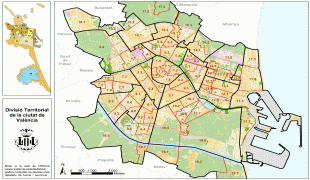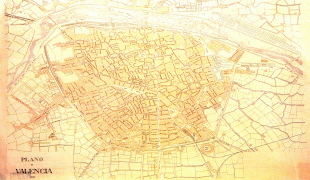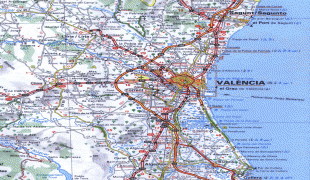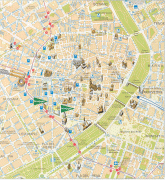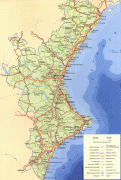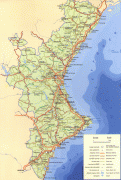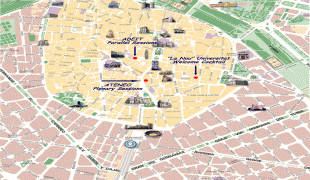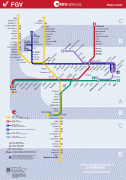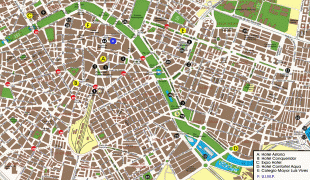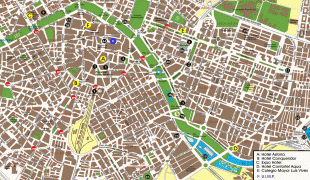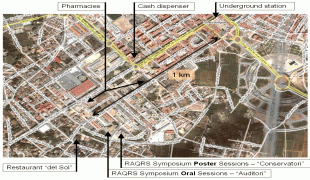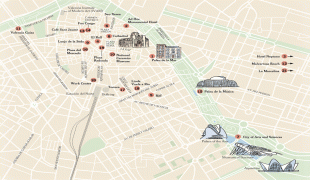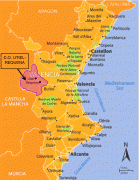Valencia
Valencia is the capital of the autonomous community of Valencia and the third-most populated municipality in Spain, with 791,413 inhabitants. It is also the capital of the province of the same name. The wider urban area also comprising the neighbouring municipalities has a population of around 1.6 million, constituting one of the major urban areas on the European side of the Mediterranean Sea. It is located on the banks of the Turia, on the east coast of the Iberian Peninsula, at the Gulf of Valencia, north of the Albufera lagoon.
Valencia was founded as a Roman colony in 138 BC. Islamic rule and acculturation ensued in the 8th century, together with the introduction of new irrigation systems and crops. Aragonese Christian conquest took place in 1238, and so the city became the capital of the Kingdom of Valencia. The city's population thrived in the 15th century, owing to trade with the rest of the Iberian Peninsula, Italian ports and other locations in the Mediterranean sea, becoming one of the largest European cities by the end of the century. Already harmed by the emergence of the Atlantic Ocean in detriment of the Mediterranean in the global trade networks and the insecurity created by Barbary piracy throughout the 16th century, the city's economic activity experienced a crisis upon the expulsion of the moriscos in 1609. The city became a major silk-manufacturing centre in the 18th century. The city served as the accidental seat of the Spanish Government from 1936 to 1937 during the Spanish Civil War.
The city's port is the 5th-busiest container port in Europe and the second busiest container port on the Mediterranean Sea. The city is ranked as a Gamma-level global city by the Globalization and World Cities Research Network. Its historic centre is one of the largest in Spain, with approximately 169 ha. Due to its long history, Valencia has numerous celebrations and traditions, such as the Falles, which were declared Fiestas of National Tourist Interest of Spain in 1965 and an intangible cultural heritage by UNESCO in November 2016. In 2022, the city was voted the world’s top destination for expats, based on criteria such as quality of life and affordability. Joan Ribó from Compromís has been the mayor of Valencia since 2015.
The Latin name of the city was Valentia, meaning "strength" or "valour", due to the Roman practice of recognising the valour of former Roman soldiers after a war. The Roman historian Livy explains that the founding of Valentia in the 2nd century BC was due to the settling of the Roman soldiers who fought against a Lusitanian rebel, Viriatus, during the Third Lusitanian Raid of the Lusitanian War.
During the rule of the Muslim kingdoms in Spain, it had the title Medina at-Tarab ('City of Joy') according to one transliteration, or Medina at-Turab ('City of Sands') according to another, since it was located on the banks of the River Turia. It is not clear if the term Balansiyya was reserved for the entire Taifa of Valencia or also designated the city.
By gradual sound changes, Valentia has become Valencia (i.e. before a pausa or nasal sound) or (after a continuant) in Castilian and València in Valencian. In Valencian, e with grave accent (è) indicates /ɛ/ in contrast to /e/, but the word València is an exception to this rule, since è is pronounced /e/. The spelling "València" was approved by the AVL based on tradition after a debate on the matter. The name "València" has been the only official name of the city since 2017.
Valencia was founded as a Roman colony in 138 BC. Islamic rule and acculturation ensued in the 8th century, together with the introduction of new irrigation systems and crops. Aragonese Christian conquest took place in 1238, and so the city became the capital of the Kingdom of Valencia. The city's population thrived in the 15th century, owing to trade with the rest of the Iberian Peninsula, Italian ports and other locations in the Mediterranean sea, becoming one of the largest European cities by the end of the century. Already harmed by the emergence of the Atlantic Ocean in detriment of the Mediterranean in the global trade networks and the insecurity created by Barbary piracy throughout the 16th century, the city's economic activity experienced a crisis upon the expulsion of the moriscos in 1609. The city became a major silk-manufacturing centre in the 18th century. The city served as the accidental seat of the Spanish Government from 1936 to 1937 during the Spanish Civil War.
The city's port is the 5th-busiest container port in Europe and the second busiest container port on the Mediterranean Sea. The city is ranked as a Gamma-level global city by the Globalization and World Cities Research Network. Its historic centre is one of the largest in Spain, with approximately 169 ha. Due to its long history, Valencia has numerous celebrations and traditions, such as the Falles, which were declared Fiestas of National Tourist Interest of Spain in 1965 and an intangible cultural heritage by UNESCO in November 2016. In 2022, the city was voted the world’s top destination for expats, based on criteria such as quality of life and affordability. Joan Ribó from Compromís has been the mayor of Valencia since 2015.
The Latin name of the city was Valentia, meaning "strength" or "valour", due to the Roman practice of recognising the valour of former Roman soldiers after a war. The Roman historian Livy explains that the founding of Valentia in the 2nd century BC was due to the settling of the Roman soldiers who fought against a Lusitanian rebel, Viriatus, during the Third Lusitanian Raid of the Lusitanian War.
During the rule of the Muslim kingdoms in Spain, it had the title Medina at-Tarab ('City of Joy') according to one transliteration, or Medina at-Turab ('City of Sands') according to another, since it was located on the banks of the River Turia. It is not clear if the term Balansiyya was reserved for the entire Taifa of Valencia or also designated the city.
By gradual sound changes, Valentia has become Valencia (i.e. before a pausa or nasal sound) or (after a continuant) in Castilian and València in Valencian. In Valencian, e with grave accent (è) indicates /ɛ/ in contrast to /e/, but the word València is an exception to this rule, since è is pronounced /e/. The spelling "València" was approved by the AVL based on tradition after a debate on the matter. The name "València" has been the only official name of the city since 2017.
Map - Valencia
Map
Country - Spain
 |
 |
| Flag of Spain | |
Anatomically modern humans first arrived in the Iberian Peninsula around 42,000 years ago. The ancient Iberian and Celtic tribes, along with other pre-Roman peoples, dwelled the territory maintaining contacts with foreign Mediterranean cultures. The Roman conquest and colonization of the peninsula (Hispania) ensued, bringing the Romanization of the population. Receding of Western Roman imperial authority ushered in the migration of different non-Roman peoples from Central and Northern Europe with the Visigoths as the dominant power in the peninsula by the fifth century. In the early eighth century, most of the peninsula was conquered by the Umayyad Caliphate, and during early Islamic rule, Al-Andalus became a dominant peninsular power centered in Córdoba. Several Christian kingdoms emerged in Northern Iberia, chief among them León, Castile, Aragon, Portugal, and Navarre made an intermittent southward military expansion, known as Reconquista, repelling the Islamic rule in Iberia, which culminated with the Christian seizure of the Emirate of Granada in 1492. Jews and Muslims were forced to choose between conversion to Catholicism or expulsion, and eventually the converts were expelled through different royal decrees.
Currency / Language
| ISO | Currency | Symbol | Significant figures |
|---|---|---|---|
| EUR | Euro | € | 2 |
| ISO | Language |
|---|---|
| EU | Basque language |
| CA | Catalan language |
| GL | Galician language |
| OC | Occitan language |
| ES | Spanish language |






